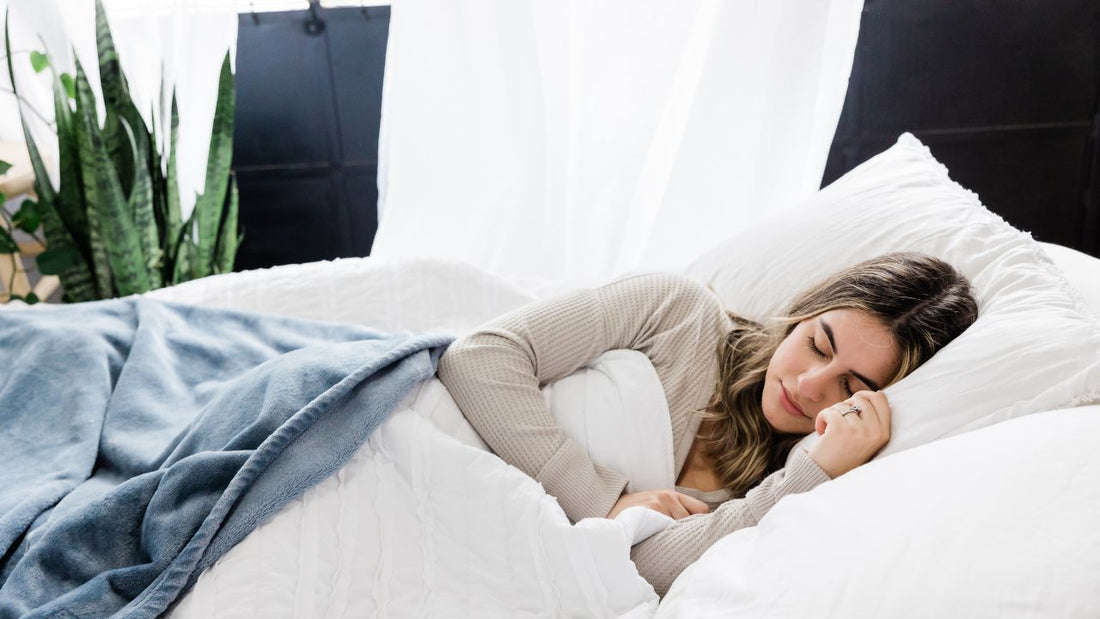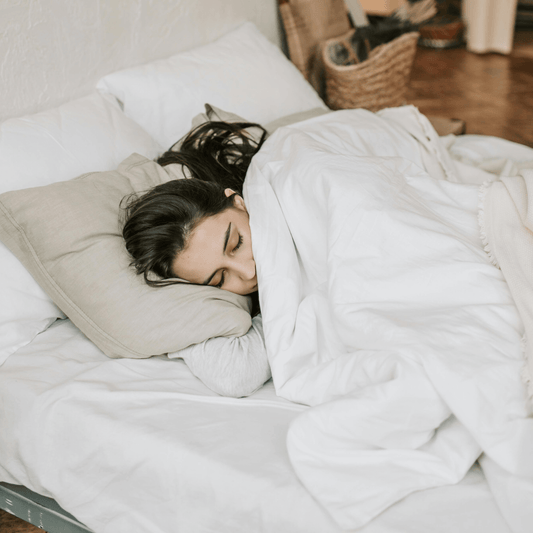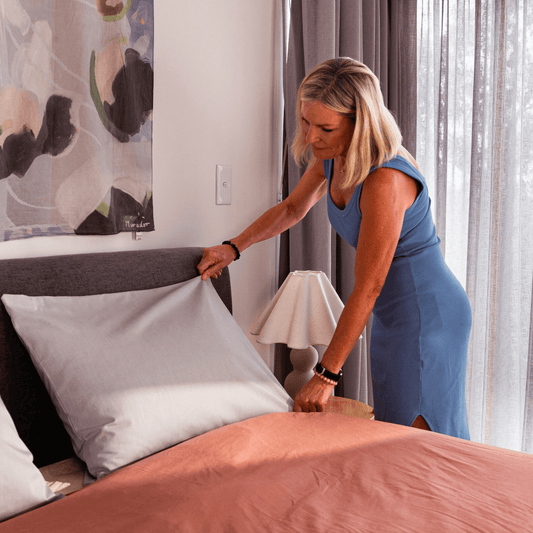
How A Grounding Bedsheet Help You Sleep Better
Grounding sheets have gained attention in recent years as people search for natural ways to sleep better, recover faster, and reduce everyday stress. These sheets look much like regular bedding but are designed with special conductive materials that connect you to the earth’s energy.
The idea may sound unusual, but it’s backed by growing interest from researchers and wellness communities alike. In this article, we’ll take a closer look at what grounding sheets are, how they’re meant to work, what the science says, and whether they’re worth adding to your sleep routine.
Key Takeaways on Grounding Sheets
- Grounding sheets are bedding products with conductive fibres that connect your body to the earth’s energy.
- They are said to improve sleep, reduce stress, ease inflammation, and support recovery.
- Research shows grounding can reduce inflammation, improve circulation, and affect stress hormones, though stronger studies are still needed.
- High-quality sheets with durable conductive fibres work best, while cheaper versions may fail over time.
- Most people can use them safely if outlets are tested and instructions are followed.
- They may work well for some but not everyone, so the experience is personal and can differ widely.
What Is a Grounding Sheet?
A grounding sheet, also known as an earthing bedsheet, is a special type of bedding made with threads that can conduct electricity, often silver. These sheets are designed to connect to the earth’s energy through a grounding cord that plugs into a grounded outlet. The idea is that by sleeping on them, your body reconnects with the earth, which some say helps reduce stress, ease inflammation, and improve sleep.
They’ve become more popular in recent years as people look for natural ways to improve health and recovery. Many people are curious about whether something as simple as a sheet can affect the body. To understand this better, it helps to look at what grounding sheets are meant to do, what benefits they might bring, and how safe they are to use.
Do Grounding Sheets Work?
Yes, grounding sheets work, especially when you buy high-quality ones that use proper conductive materials. These fibres make sure your body is actually connected to the earth’s electrical charge while you sleep. Cheaper versions often lose conductivity quickly, meaning they may not provide the same benefits over time.
Research has found some promising effects of grounding. Clinical reports have shown improvements in inflammation and wound healing when people stayed grounded for long periods, with one study noting measurable changes in immune markers.
Other research has linked grounding to better blood flow and improved sleep patterns, including lower stress hormone levels at night. While the studies are still small and more evidence is needed, the science suggests grounding can have real effects on the body when done correctly.
For some people, this translates to falling asleep more easily, waking up with less stiffness, or simply feeling more balanced. The key is that the sheets must be well-made and used properly for these benefits to be possible.
How Grounding Sheets Work Behind the Scenes

Grounding sheets work by creating a direct connection between your body and the earth’s natural electrical field. The sheets are woven with conductive fibres, such as silver or stainless steel, which can carry the earth’s free electrons.
When the sheet is connected to a grounded outlet or rod, those electrons travel through the cord, spread across the sheet, and are absorbed by your body while you sleep. This process is thought to balance the body’s electrical charge and may help regulate stress hormones, reduce inflammation, and improve sleep quality.
The flow is simple: Earth → Grounding Cord → Conductive Sheet → Human Body → Physiological Effects.
This chain explains why proper setup and quality materials matter. If the cord or sheet is poorly made, the connection weakens and the potential benefits are lost.
What Are the Benefits of Using Grounding Sheets?
People who use grounding sheets often report a range of benefits. These usually include:
- Better Sleep: Sleeping more deeply and waking up feeling more refreshed
- Helps With Anxiety: Feeling less anxious or stressed at night
- Reduced Inflammation: Lower levels of pain and inflammation, which may be helpful for chronic conditions
- Boosts Muscle Recovery: Quicker recovery after exercise or physical strain
- Makes You Feel Relaxed: Improved mood, energy, and focus during the day
Some early studies suggest that grounding may influence the body’s natural rhythms, like cortisol levels, which play a role in stress and sleep. By lowering stress markers, grounding sheets may help you feel more balanced.
Athletes sometimes use them in the hope of speeding up muscle recovery, while others focus on their potential to improve sleep quality. While these benefits sound promising, it’s important to remember that stronger research is still needed.
The Science Behind Grounding
There is some evidence supporting the idea of grounding, but it’s still considered early and not yet conclusive. For example, research published in recent years has suggested grounding can reduce inflammation and improve circulation. It even helps regulate blood sugar and potentially prevent osteoporosis. Some reports have described improved healing and better sleep quality among people who stayed grounded for longer periods.
These findings show that grounding isn’t just an idea; it can have measurable effects on the body. But results are most likely when the grounding products are of good quality and maintain proper conductivity. Experts still stress the need for larger studies to fully confirm these outcomes, but so far, the evidence gives grounding sheets credibility beyond simple anecdotal stories.
How Do You Use Grounding Sheets Safely?
Setting up grounding sheets is straightforward, but it’s worth knowing the right way to do it.
Here’s how:
- Place the grounding sheet on your mattress like a normal fitted sheet, making sure the conductive side is facing up.
- Attach the grounding cord to the sheet using the snap-on connector.
- Plug the other end of the cord into the grounding port of a properly wired wall outlet, or connect it to a grounding rod if supplied.
- Always test your outlet first using a grounding tester to make sure it’s safe and properly wired.
Learn more: How to test grounding products in 5 simple steps
To keep them safe and effective:
- Avoid using grounding sheets during thunderstorms, as lightning could pose a risk.
- Check that your outlets are properly grounded before plugging in.
- Wash the sheets gently, avoiding bleach or harsh detergents that can damage the silver threads.
When used correctly, grounding sheets don’t carry electrical current into your body. They simply connect you to the ground line of the outlet, which makes them safe for most households.
Are Grounding Sheets Safe for Everyone?
For most people, grounding sheets are considered safe. They don’t send electricity into your body but simply provide a pathway for grounding. Still, some groups should be cautious:
- People with pacemakers or other implanted medical devices should check with their doctor before using grounding sheets.
- Pregnant women may want to get advice from their healthcare provider.
- Those who consider themselves sensitive to electricity might find grounding sheets uncomfortable, though this is rare.
In general, if you follow the instructions and take care with outlet testing, grounding sheets are safe for everyday use.
They’re a low-risk wellness option, but as with anything related to health, it’s always best to get personalised medical advice if you’re unsure.
How Do Grounding Sheets Compare to Other Grounding Products?
Grounding sheets are one of the most convenient options because you can use them overnight without having to change your daily habits. Compared to other products:
- Grounding mats: These are usually placed under your feet while you sit at a desk or relax at home. They’re good for daytime grounding but don’t cover as much of the body.
- Patches and bands: These target specific areas of the body, like an injured muscle or joint. They’re helpful for short-term or local use but not practical for all-night grounding.
- Wrist or ankle straps: Lightweight and portable, but not as comfortable or effective for long sessions.
Grounding sheets cover the whole body while you sleep, which makes them a good choice if you want long, consistent grounding sessions. Mats, patches, and straps are better if you’re looking for something flexible during the day.
Should You Buy Grounding Sheets?
If you’re interested in natural ways to improve sleep or reduce stress, grounding sheets might be worth trying. Some people feel a noticeable difference after using them, while others don’t see much change.
Before buying, it’s worth thinking about a few points:
- Quality: High-quality sheets with proper conductive fibres are more reliable and effective. Cheaper ones may lose conductivity and stop working properly after a few washes.
- Cost: Grounding sheets are more expensive than standard sheets, so it’s an investment.
- Scientific evidence: The research is promising but still limited, so benefits aren’t guaranteed.
- Setup: You’ll need to test your outlets and follow instructions to make sure you’re using them safely.
If you're leaning toward trying one, consider a product designed with both science and durability in mind. Our earthing sheet, for instance, is crafted with about 30% stainless steel mesh, which means durable conductivity and resistance to damage from lotions, oils, or frequent washing.
This fabric structure helps it stay connected over time and keep working effectively. It’s supported by a 3-year warranty and a 90-day risk-free trial, showing confidence in its quality and performance.
References
Chevalier, G., Sinatra, S. T., & Oschman, J. L. (2015). Earthing: Health implications of reconnecting the human body to the Earth's surface electrons. Journal of Inflammation Research, 8, 83–96. https://doi.org/10.2147/JIR.S69656
Chevalier, G., Mori, K., & Oschman, J. L. (2015). One-hour contact with the Earth’s surface (grounding) improves inflammation and blood flow: A randomized double-blind pilot study. Health, 7(7), 1022–1059. https://doi.org/10.4236/health.2015.78119
Sokal, K., & Sokal, P. (2011). Earthing the human body influences physiologic processes. Journal of Alternative and Complementary Medicine, 17(4), 301–308. https://doi.org/10.1089/acm.2010.0687
Menigoz, W., Latz, T. T., Ely, D., Kamei, C., Melvin, G., & Sinatra, S. T. (2020). The effects of grounding (earthing) on inflammation, the immune response, wound healing, and prevention and treatment of chronic inflammatory and autoimmune diseases. Alternative Therapies in Health and Medicine, 26(S2), 20–32. PMID: 32266554
Del, R. C., & Ramaraj, R. (2024). Earthing as an integrative treatment for anxiety: A review. Medical Research Archives, 12(12). https://doi.org/10.18103/mra.v12i12.6024










